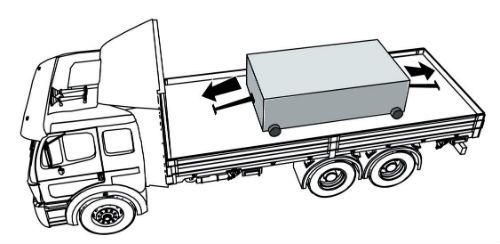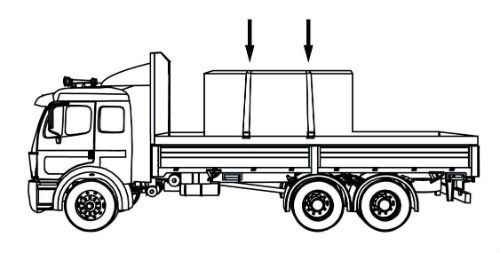CDL Practice Tests: Flatbed Cargo Securement
Choose A Section:
Go!How much force is the securement system required to withstand in terms of cargo weight?
- 80% forward, 50% rearward, 50% sideways, 20% upwards.
- 50% forward, 50% rearward, 50% sideways, 80% upwards.
- 80% forward, 50% rearward, 80% sideways, 20% upwards.
- 50% forward, 20% rearward, 50% sideways, 20% upwards.
How strong must the vehicle structure and anchor points be?
All elements of the vehicle structure and anchor points must be strong enough to withstand the forces described on page 7.
- Forward force: 0.8 g (80%)
- Rearward force: 0.5.g (50%)
- Sideways force: 0.5 g (50%)
- Upward force: 0.2 g (20%)
What is the minimum aggregate WLL for a group of concrete pipe weighing 16,000 lbs?
- 10,000 lbs
- 7,999 lbs
- 8,001 lbs
- 5,000 lbs
General tiedown requirements
The aggregate working load limit of all tiedowns on any group of pipe must be more than half the total weight of all pipes in the group.
When securing concrete pipe loaded crosswise, arrange the top tier:
- Any of these are acceptable.
- As a partial tier in one group.
- As a partial tier in two groups.
- As a complete tier.
Requirements for arranging the top tier

Arrange the top tier as a complete tier, a partial tier in one group, or a partial tier in two groups.
What is the maximum weight that can be secured by a tiedown with a marked WLL of 5,000 lbs?
- 5,000 lbs
- 10,000 lbs
- 6,000 lbs
- 2,500 lbs
Note: The minimum WLL requirement for the securement system is 50%. More tiedown capacity should be used if you need to secure an article against any movement.
One option of positioning bundles of building materials is:
- Turn them so only their corners are touching.
- Place them in direct contact with each other.
- Lean them against each other.
- Lean them to the outside.
Choose one of two options for positioning bundles:
-
Option #1:
Place bundles in direct contact with each other.
-
Option #2:
Provide a means (such as dunnage or blocking) to prevent the bundles from shifting towards each other.
When securing a load of lengthwise longwood logs weighing 42,500 lbs, what is the minimum aggregate WLL required for tiedowns? (rounded up to nearest lb)
- 7,085 lbs.
- 21,250 lbs
- 8,550 lbs
- 10,000 lbs
Working load limit for longwood and shortwood loaded lengthwise
The aggregate working load limit for all tiedowns must be no less than 1/6 the weight of the stack of logs.
Note: This requirement is much less than the general requirement of an aggregate working load limit equal to 1/2 the weight of the load. This lowered requirement recognizes that the bunks/stakes help to prevent slippage.
When a tiedown is attached directly to the cargo, what is the ideal angle where it attached to the vehicle?
- Between 45 and 60 degrees.
- Less than 45 degrees.
- It doesn't matter.
- 90 degrees.
The angle where the tiedown attaches to the vehicle should be shallow, not deep (ideally less than 45).
As part of their pre-trip cargo securement inspection, drivers should:
- Make sure cargo is properly secured.
- All of these apply.
- Inform carrier of any inadequate packaging.
- Check for anything that will obscure their vision.
Driver inspection checklist:
Pre-Trip
- Make sure that cargo is properly distributed and adequately secured (in other words, according to the Standard).
- Make sure that all securement equipment and vehicle structures are in good working order and used consistent with their capability.
- Stow vehicle equipment.
- Make sure that nothing obscures front and side views or interferes with the ability to drive the vehicle or respond in an emergency.
-
Inform carrier if packaging is not adequate. For example:
- Banding is loose or not symmetrical on package.
- Banding attachment device(s) are inefficient.
- Wrapping is broken or ineffective.
- Pallets are broken.
Who is responsible for inspecting securing devices and cargo within the first 50 miles?
- The driver.
- Your Moms.
- The D.O.T.
- The shipper.
Inspect Cargo and Securing devices:
- Pre-Trip: Yes
- Within first 50 mi: Yes
- When duty status of driver changes: Yes
- At 3 hour intervals or every 150 mi, whichever is first: Yes
A stack of shortwood loaded lengthwise can be secured with one tiedown if:
- All of these apply.
- All logs in the stack are less than 10 ft long.
- They are blocked in the back by the vehicle's end structure or another stack of logs.
- They are blocked in the front by a headboard or another stack of logs.
One tiedown
A stack can be secured with one tiedown if all logs in the stack less than 3.04 m (10 ft) are:
- Blocked in the front by a headboard strong enough to restrain the load or by another stack of logs.
- Blocked in the rear by the vehicle's end structure or another stack of logs.
About The Flatbed Cargo Securement CDL Manual
Studying the flatbed cargo securement CDL manual is not a requirement for getting your CDL permit or license. It is required knowledge for flatbed drivers.
Some questions you should be able to answer for flatbed cargo securement:
- What is the minimum Working Load Limit of a tiedown used to secure logs?
- What is the minimum weight of a shipment of paper rolls that would require specific securement requirements?
- When securing concrete pipe over 45 inches loaded crosswise, which direction must the tiedowns on the front half of the load run?
- What is a cab shield?
- When securing concrete pipe over 45 inches loaded crosswise, which direction must the tiedowns on the rear half of the load run?
- What is a dunnage bag?
- Who is responsible for inspecting securing devices and cargo within the first 50 miles?
- How many tiedowns are required on a stack of shortwood loaded crosswise?
- What is the minimum working load limit of each tiedown used to secure crushed or flattened vehicles?
- Define 'bolster'
- What is a hook-lift container?
- When a tiedown is attached directly to the cargo, what is the ideal angle where it attached to the vehicle?
What is a securing device?
Any device specifically manufactured to attach or secure cargo to a vehicle or trailer:
- Synthetic Webbing
- Chain
- Wire rope
- Manila rope
- Synthetic rope
- Steel strapping
- Clamps and latches
- Blocking
- Front-end structure
- Grab hooks
- Binders
- Shackles
- Winches
- Stake pockets
- D-rings
- Webbing ratchet
- Bracing
- Friction mat
What is a tiedown?
A combination of securing devices that forms an assembly that:
- Attaches cargo to, or restrains cargo on a vehicle.
- Is attached to anchor point(s).

Some tiedowns are attached to the cargo and provide direct resistance to restrain the cargo from movement.

Some tie-downs pass over or through the cargo. They create a downward force that increases the effect of friction between the cargo and the deck. This friction restrains the cargo.
 Related Cargo Securement Terms That Every Driver Should Know:
Related Cargo Securement Terms That Every Driver Should Know:
-
Tiedown:
A combination of securing devices which form an assembly that attaches cargo to, or restrains cargo on, a vehicle or trailer, and is attached to anchor point(s).
-
Contained:
Cargo is contained if it fills a sided vehicle, and every article is in contact with or sufficiently close to a wall or other articles so that it cannot shift or tip if those other articles are also unable to shift or tip.
-
Blocking:
A structure, device, or another substantial article placed against or around an article to prevent horizontal movement of the article.
How should tiedowns be attached?
Tiedowns can be used in two ways:
-
Attached to the cargo:
- Tiedowns attached to the vehicle and attached to the cargo.
- Tiedowns attached to the vehicle, pass through or aroundan article of cargo, and then are attached to the vehicle again.
-
Pass over the cargo:
- Tiedowns attached to the vehicle, passed over the cargo, and then attached to the vehicle again.
Tiedown placement:

Place the tiedown as close as possible to the spacer.
Position the tiedowns as symetrically as possible over the length of the article.

Position the tiedowns to preserve the integrity of the article.







 TT On Facebook
TT On Facebook